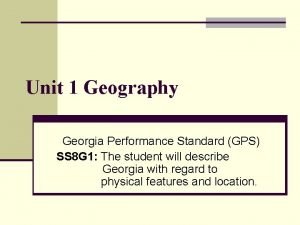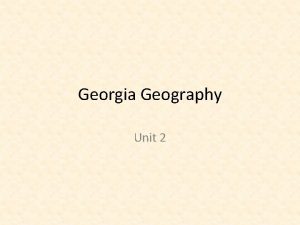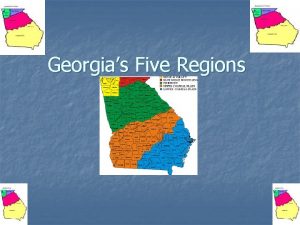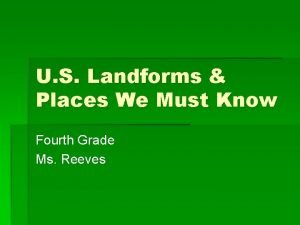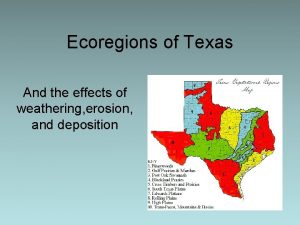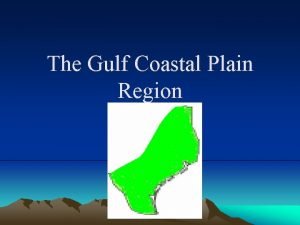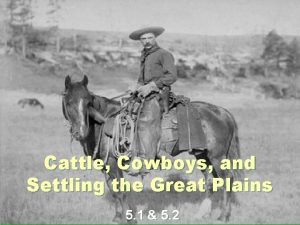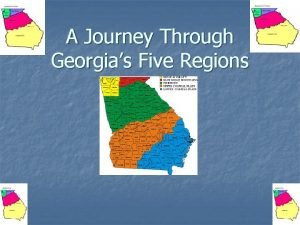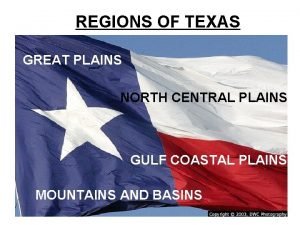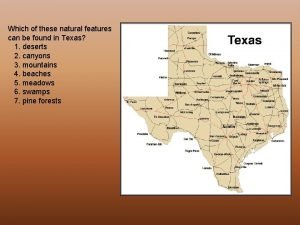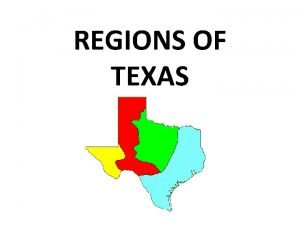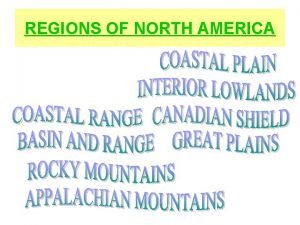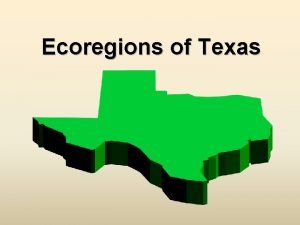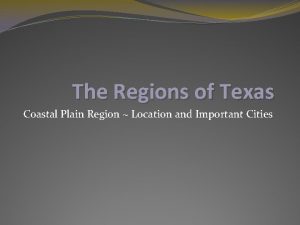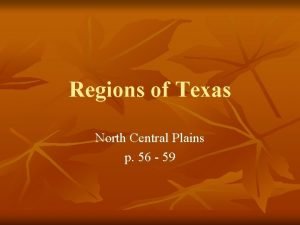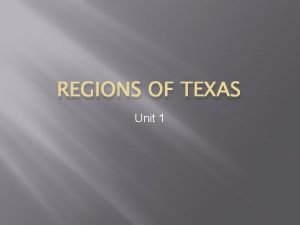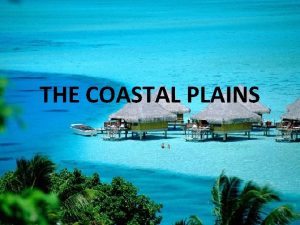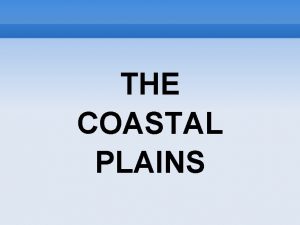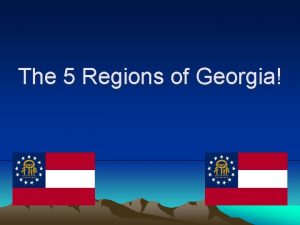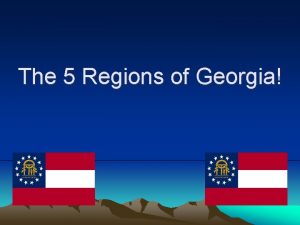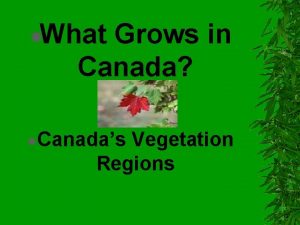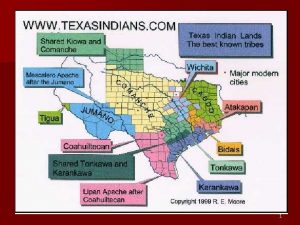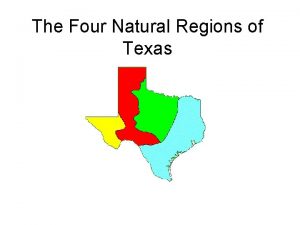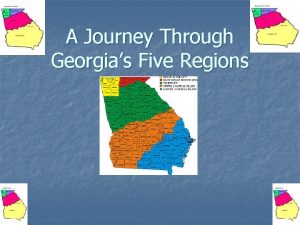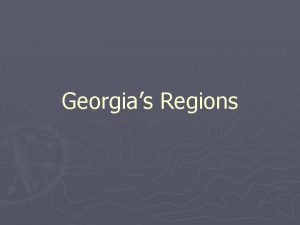The 5 Regions of Georgia Coastal Plains Vegetation



















- Slides: 19

The 5 Regions of Georgia!


Coastal Plains • Vegetation – soil is not fertile. It consist of sand clay. Areas are poorly drained and swampy. Only pine trees and brush can survive in this region. • Climate - hot summers/ mild winters • Agriculture – turpentine. The land is used for pasture.

Coastal Plains 2 • Industry – pecans, paper, pulp • Natural resources – groundwater, timber • Major towns and cities – Albany, Savannah, Macon, Columbus, Augusta, Fort Valley, Valdosta

Coastal Plains 3 • Tourist attractions – Okefenokee National Wildlife Refuge, Reed Bingham State Park, and the Colquitt County Arts Center. • Rivers – Satilla, Canoochee, Ohoopee, Brier, Altamaha, Ocmulgee • Lakes – Lake Blackshear, Lake Walter George, Lake Seminole


Piedmont • Vegetation- oak, hickory, pine forests and mixed deciduous forests. Short–leaf pine, and loblolly pine. Sweet gum, beach, red maple, elms, and birches. • Climate- hot summers/ mild winters • Agriculture- cotton, soybeans, and wheat.

Piedmont 2 • Industry- granite, textiles, farming, poultry. • Natural Resources- surface water- reservoirs, streams, rivers, etc. • Major Towns and Cities- Atlanta, Marietta, Roswell, Athens, East Point.

Piedmont 3 • Tourist Attractions- Six Flags, White Water, Stone Mountain, Georgia Aquarium, Zoo Atlanta. • Rivers- Chattahooche, Yellow River, Ogeechee River, Apalachee River, Flint River. • Lakes- Lake Oconee, Lake Jackson, Lake Sulieffe, Lake Sinclair.

Blue Ridge • Vegetation – oak and hickory • Climate – mild summers/ cold winters. There are great amounts of rainfall. • Agriculture – apples, corn, and other vegetables. The growing season varies from 210 days and 180 days depending on where you are in the region.

Blue Ridge 2 • Industry – marble, gold coins • Natural resources – surface water, hardwood timber, marble • Major towns and cities – Clayton, Brass town Bald, Dahlonega, Blue Ridge

Blue Ridge 3 • Tourist attractions – Brass Town Bald, Springer Mountain (it is the beginning of the App. Trail), panning for gold • Rivers – Nottely River, Tugaloo River, Hestatee River • Lakes – Lake Nottely, Lake Blue Ridge, Lake Lanier, Lake Chatuge

Ridge and Valley • Vegetation- the sandstone ridges are forest-covered. Plant species very from area to area, based on local soil type, elevation, moisture, and disturbances. • Climate- mild summers/mild winters • Agriculture- Valley floors are used for farming and pasture. Has an average growing season of 210 to 220 days. Corn, soybeans, wheat, cotton, and other crops, are grown in this area. Much of the land is used for harvesting hardwood and pine timber.

Ridge and Valley 2 • Industry- textiles, carpets (Dalton is the carpet capital of the world). • Natural Resources- surface water, different sedimentary deposits. • Tourist Attractions- Chickamaugu Valley, Amuchee Ridges, and the Great Valley.

Ridge and Valley 3 • Rivers- Conasaugu River, Coosawottee River, Oostanaula River. • Lakes- Lake Allatoona, Carters Lake • Major Towns and Cities- Dalton, Rome, Ringgold, Chatsworth.

Appalachian Plateau • Vegetation – Oak forests cover most of the province. Forests on north side include basswood, sugar maple, tulip poplar, beech, birch, and hemlock. The under story may include rhododendrons, native azaleas, and mountain laurel. • Climate – mild summers/mild winters • Agriculture – Land is primarily used for hardwood forest and pasture, although a small amount of corn and soybeans is grown here.

Appalachian Plateau 2 • Industry – coal industries • Natural resources – surface water, timber, coal • Major Cities and Towns – La Fayette, Trenton, Fort Oglethorpe

Appalachian Plateau 3 • Tourist attractions – Cumberland Plateau : Sand Mountain and Lookout Mountain. East of Lookout Mountain is the thumb-like Pigeon Mountain. • Rivers – Chattooga River • Lakes - none

 Coastal plains ga to columbus georgia gps
Coastal plains ga to columbus georgia gps Coastal plains ga to columbus georgia gps
Coastal plains ga to columbus georgia gps Coastal plain region of georgia
Coastal plain region of georgia Balcones escarpment
Balcones escarpment What does the coastal plains look like
What does the coastal plains look like South texas plains weathering
South texas plains weathering Subregions of coastal plains
Subregions of coastal plains Gulf coastal plains
Gulf coastal plains Varsha bhat
Varsha bhat Climate of coastal plains
Climate of coastal plains North central plains region of texas
North central plains region of texas Llano uplift plants
Llano uplift plants Regions of texas
Regions of texas Interior lowlands facts
Interior lowlands facts Post oak savannah erosion
Post oak savannah erosion What are the ecoregions of texas
What are the ecoregions of texas Coastal plains map texas
Coastal plains map texas Map of north central plains
Map of north central plains Vegetation in the innuitian mountains
Vegetation in the innuitian mountains North central plains vegetation
North central plains vegetation
